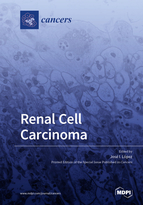Renal Cell Carcinoma
A special issue of Cancers (ISSN 2072-6694).
Deadline for manuscript submissions: closed (30 November 2019) | Viewed by 137396
Special Issue Editor
Interests: translational uropathology; pathological diagnosis; basic fundamentals of tumor biology
Special Issues, Collections and Topics in MDPI journals
Special Issue Information
Dear Colleagues,
Renal cancer is a complex disease and a leading cause of mortality in Western countries. This tumor is regularly included in the top-ten list of the most frequent neoplasms, with around 77,000 new cases (44,120 in males and 29,700 in females) expected only in the USA in 2019. The growing aging and obesity rates detected in developed societies are factors that predict a continuous increase in the incidence of this tumor in the next decade. Further, renal cancer is a health problem of major concern considering its well-known chemo- and radio-resistance. In fact, although tyrosine kinase inhibitors and immune check-point blockade therapies are giving promising results, at present the only methods that have a direct impact on patients’ survival are early detection and surgery.
The spectrum of renal cell carcinoma subtypes is wide. Up to 70–80% of renal tumors are clear cell renal cell carcinomas, a clinically aggressive tumor subtype linked to VHL gene inactivation. Next in frequency, the papillary renal cell carcinoma category encompasses an intricate puzzle of classic and newly described entities with poorly defined limits, some of them pending definite clarification. Likewise, the chromophobe–oncocytoma duality, the so-called hybrid tumors and oncocytic neoplasms, not otherwise specified, remain to be well profiled. Finally, a growing list of very uncommon renal tumors linked to specific molecular signatures (SDH-deficient carcinomas, translocation renal cell carcinomas, etc.) fulfill the current portrait of renal cell neoplasia.
This Special Issue of Cancers intends to take a translational snapshot of the current knowledge in renal cancer, from the simplest clinical approach to the most sophisticated molecular methodology. More than ever, a multidisciplinary perspective is mandatory to solve contemporary dilemmas in this field.
Prof. José I. López
Guest Editor
Manuscript Submission Information
Manuscripts should be submitted online at www.mdpi.com by registering and logging in to this website. Once you are registered, click here to go to the submission form. Manuscripts can be submitted until the deadline. All submissions that pass pre-check are peer-reviewed. Accepted papers will be published continuously in the journal (as soon as accepted) and will be listed together on the special issue website. Research articles, review articles as well as short communications are invited. For planned papers, a title and short abstract (about 100 words) can be sent to the Editorial Office for announcement on this website.
Submitted manuscripts should not have been published previously, nor be under consideration for publication elsewhere (except conference proceedings papers). All manuscripts are thoroughly refereed through a single-blind peer-review process. A guide for authors and other relevant information for submission of manuscripts is available on the Instructions for Authors page. Cancers is an international peer-reviewed open access semimonthly journal published by MDPI.
Please visit the Instructions for Authors page before submitting a manuscript. The Article Processing Charge (APC) for publication in this open access journal is 2900 CHF (Swiss Francs). Submitted papers should be well formatted and use good English. Authors may use MDPI's English editing service prior to publication or during author revisions.







